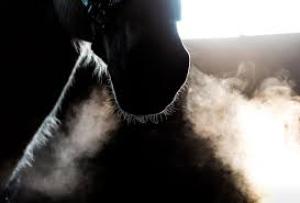
By Vet Charlotte Pennington
Winter can be challenging for horse respiratory health due to the weather change and also the management and environmental changes associated with it.
Firstly, colder air can itself be an airway irritant. Secondly, due to the weather and shorter days horses tend to be stabled for much longer. This can lead to increased exposure to environmental airway irritants such as airborne dust. When a horse's airway is irritated, inflammation occurs producing symptoms such as coughing, nasal discharge and exercise intolerance.

Although common infectious diseases such as Equine Influenza and Herpesvirus can be spread all year round, stabling horses for longer periods of time can be stressful for them. Also increased close contact between horses and sharing air spaces for long periods of time can increase the risk of spread of some infectious diseases.
With regards to the infectious diseases, on busy yards maintaining good hygiene practices is essential such as avoiding or disinfecting shared equipment like buckets. If horses are unwell they should be isolated, examined by the vet and if necessary, samples taken to help guide specific treatment alongside taking precautions to prevent any further spread of disease.
For horses with environmental related/allergic airway disease, the key to improving symptoms is reducing exposure to the things that are irritating the horse’s airway.
It can be hard to find the exact cause sometimes, but common causes of irritation can be dust from hay or bedding and mould or spores in hay, all of which our horses are more exposed to over winter.
Simple management changes can help avoid exposure to airway irritants including avoiding straw, and using dust extracted bedding.
Mucking out and bedding down the stable without the horse in the stable while you do so, reduces dust exposure. Ideally the horse would not be brought back in for an hour to allow any dust to settle. Consider where hay bales and straw are stored in relation to the horse’s stable.
Ensure good ventilation, air flow and drainage in the stable and feed hay/feed from the ground to encourage drainage of mucus from airways.
Soak hay for at least 30 minutes prior to feeding to reduce the dust levels (but not the nutritional content for which longer soaking is needed).
Steaming hay is very beneficial as the high temperatures kill mould spores, though it is a significant investment for the steamer machines.
Discard and do not feed any mouldy hay/haylage and ensure turnout where possible - assuming the horse is not allergic to anything in the pasture.
Where an infectious disease is suspected treatment depends on the cause, but prompt isolation and biosecurity are key. For environmental respiratory disease, the mainstay of treatment is management changes to avoid airway irritants as discussed above. More severe cases may require medication such as steroid treatment to reduce inflammation, or other medications to open the airways and assist in clearing the mucus and ease breathing.
But most importantly treatment with medication should be in conjunction with implementing environmental changes to help avoid recurrence of the problem.
The medications come in a variety of formats and can be used both short and long term.
Injections and oral medication are good for initial stabilisation of signs, however for longer term use there are a variety of products that allow medicines to be delivered via nebulisers (ie directly into the airways) which has benefits in that smaller amounts of medication are needed and are being delivered directly to the site they are needed.
Occasionally, respiratory conditions persist despite best efforts, initial management changes and treatment, and further investigation is required. This can involve passing an endoscope (camera) into the airways to check for any abnormalities and allow diagnostic samples to be taken.